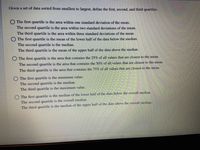
MATLAB: An Introduction with Applications
6th Edition
ISBN: 9781119256830
Author: Amos Gilat
Publisher: John Wiley & Sons Inc
expand_more
expand_more
format_list_bulleted
Question
I need help with this problem please.

Transcribed Image Text:Given a set of data sorted from smallest to largest, define the first, second, and third quartiles.
O The first quartile is the area within one standard deviation of the mean.
The second quartile is the area within two standard deviations of the mean.
The third quartile is the area within three standard deviations of the mean.
O The first quartile is the mean of the lower half of the data below the median.
The second quartile is the median.
The third quartile is the mean of the upper half of the data above the median.
O The first quartile is the area that contains the 25% of all values that are closest to the mean.
The second quartile is the area that contains the 50% of all values that are closest to the mean.
The third quartile is the area that contains the 75% of all values that are closest to the mean.
O The first quartile is the minimum value.
The second quartile is the median.
The third quartile is the maximum value.
The first quartile is the median of the lower half of the data below the overal median.
The second quartile is the overall median.
The third quartile is the median of the upper half of the data above the overall median.
Expert Solution
This question has been solved!
Explore an expertly crafted, step-by-step solution for a thorough understanding of key concepts.
This is a popular solution
Trending nowThis is a popular solution!
Step by stepSolved in 2 steps

Knowledge Booster
Similar questions
- I bought a new gas lawn mower the other day. This new mower mows faster than the old electric (environmental) one. Why, you ask? It is because the old mower cut a 21 inch path, while the new one cuts a 22 inch path. So how much time did I save? Look at some facts. My lawn is a rectangle measuring 150 feet by 105 feet I mow the lawn in strips and always in the same direction (length or width) My walking speed is 120 feet/minute It takes 5 seconds to turn around after each strip How much time did I save if I mow back and forth along the width or if I mow back and forth along the length? Pick one and figure it out. My neighbor does not like minutes the noise it makes, but I do!arrow_forwardPlease describe the answers step by step since it is difficult to figure it out since the answers are cut off.arrow_forwardI need step by step explanarrow_forward
- Is the solution only the last table? Thank you very mucharrow_forwardCan you explain further more from line 9 to the end pleasearrow_forwardI bought a new gas lawn mower the other day. This new mower mows faster than the old electric (environmental) one. Why, you ask? It is because the old mower cut a 21 inch path, while the new one cuts a 22 inch path. So how much time did I save? Look at some facts. My lawn is a rectangle measuring 150 feet by 105 feet I mow the lawn in strips and always in the same direction (length or width) My walking speed is 120 feet/minute It takes 5 seconds to turn around after each strip How much time did I save if I mow back and forth along the width or if I mow back and forth along the length? Pick one and figure it out. My neighbor does not like minutes the noise it makes, but I do!arrow_forward
- Part c looks incomplete. Can it be reviewed please.arrow_forwardYou are designing a poster which has a border around the printed portion. The border is 2 inches wide on the left and right sides, and 3 inches wide on the top and bottom. The entire poster will be a total of 300 square inches, including the borders and printed portion combined.arrow_forwardI am extremely confused and need help because this is due todayarrow_forward
arrow_back_ios
arrow_forward_ios
Recommended textbooks for you
 MATLAB: An Introduction with ApplicationsStatisticsISBN:9781119256830Author:Amos GilatPublisher:John Wiley & Sons Inc
MATLAB: An Introduction with ApplicationsStatisticsISBN:9781119256830Author:Amos GilatPublisher:John Wiley & Sons Inc Probability and Statistics for Engineering and th...StatisticsISBN:9781305251809Author:Jay L. DevorePublisher:Cengage Learning
Probability and Statistics for Engineering and th...StatisticsISBN:9781305251809Author:Jay L. DevorePublisher:Cengage Learning Statistics for The Behavioral Sciences (MindTap C...StatisticsISBN:9781305504912Author:Frederick J Gravetter, Larry B. WallnauPublisher:Cengage Learning
Statistics for The Behavioral Sciences (MindTap C...StatisticsISBN:9781305504912Author:Frederick J Gravetter, Larry B. WallnauPublisher:Cengage Learning Elementary Statistics: Picturing the World (7th E...StatisticsISBN:9780134683416Author:Ron Larson, Betsy FarberPublisher:PEARSON
Elementary Statistics: Picturing the World (7th E...StatisticsISBN:9780134683416Author:Ron Larson, Betsy FarberPublisher:PEARSON The Basic Practice of StatisticsStatisticsISBN:9781319042578Author:David S. Moore, William I. Notz, Michael A. FlignerPublisher:W. H. Freeman
The Basic Practice of StatisticsStatisticsISBN:9781319042578Author:David S. Moore, William I. Notz, Michael A. FlignerPublisher:W. H. Freeman Introduction to the Practice of StatisticsStatisticsISBN:9781319013387Author:David S. Moore, George P. McCabe, Bruce A. CraigPublisher:W. H. Freeman
Introduction to the Practice of StatisticsStatisticsISBN:9781319013387Author:David S. Moore, George P. McCabe, Bruce A. CraigPublisher:W. H. Freeman

MATLAB: An Introduction with Applications
Statistics
ISBN:9781119256830
Author:Amos Gilat
Publisher:John Wiley & Sons Inc

Probability and Statistics for Engineering and th...
Statistics
ISBN:9781305251809
Author:Jay L. Devore
Publisher:Cengage Learning

Statistics for The Behavioral Sciences (MindTap C...
Statistics
ISBN:9781305504912
Author:Frederick J Gravetter, Larry B. Wallnau
Publisher:Cengage Learning

Elementary Statistics: Picturing the World (7th E...
Statistics
ISBN:9780134683416
Author:Ron Larson, Betsy Farber
Publisher:PEARSON

The Basic Practice of Statistics
Statistics
ISBN:9781319042578
Author:David S. Moore, William I. Notz, Michael A. Fligner
Publisher:W. H. Freeman

Introduction to the Practice of Statistics
Statistics
ISBN:9781319013387
Author:David S. Moore, George P. McCabe, Bruce A. Craig
Publisher:W. H. Freeman